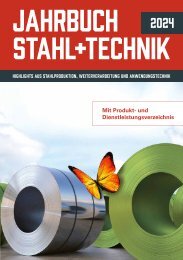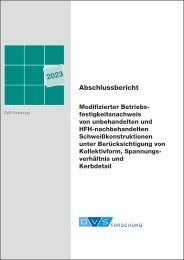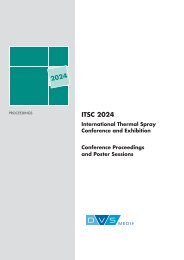STEEL + TECHNOLOGY 04/2019 EXTRACT
STEEL + TECHNOLOGY 04/2019 EXTRACT
STEEL + TECHNOLOGY 04/2019 EXTRACT
Create successful ePaper yourself
Turn your PDF publications into a flip-book with our unique Google optimized e-Paper software.
<strong>STEEL</strong> <strong>TECHNOLOGY</strong> | 69<br />
Figure 2. Flattener for the 3rd generation grades (Picture: Fives)<br />
issue that was considered to be solved<br />
long time ago: introduction of the flat strip<br />
at the entry shear. Our study for mechanical<br />
equipment to produce the 3rd generation<br />
grade shows that a threading flattener<br />
needs specific design as shown in figure<br />
2 to support additional constrain to<br />
straighten the strip. To avoid roll deformation,<br />
stiffeners are to be installed to succeed<br />
proper threading.<br />
Bending and tension control<br />
Strip mechanical properties impact strip<br />
transportation design not only regarding<br />
tension requirements for a skin-pass mill<br />
and a tension leveller, but also roll angle<br />
losses, as well as energy consumption for<br />
strip bending with consequences on bridle<br />
configuration, strip guiding and electrical<br />
consumption. In order to meet the requirements<br />
of new steel grade production,<br />
Fives developed DMS OptiLine, a precise<br />
software tool, which simulates the<br />
complete running of a strip processing line.<br />
It calculates the requested characteristics<br />
of each motor of the line based on the tension<br />
map request and mechanical properties<br />
received from upstream facilities and<br />
targeted at line exit. It guarantees the<br />
required line tension during operation at<br />
the constant speed, as well as during line<br />
acceleration and deceleration. Accumulators<br />
are also checked according to the real<br />
product mix of the line.<br />
The DMS OptiLine is designed to<br />
achieve the best possible performance by<br />
anticipating every operating scenario and<br />
offering appropriate responses:<br />
• anticipate quality risk linked with strip<br />
driving to prepare development of new<br />
grades or new strip dimensions,<br />
• optimize need of change (motor, bridle,<br />
pinch roll) during a revamping project.<br />
The production is simulated as shown in<br />
figure 3 with a line speed variation, strip<br />
dimension changes and a grade transition<br />
phase. This insight can significantly reduce<br />
the time taken for commissioning.<br />
Skin-pass and levelling<br />
Steelmakers’ needs concerning skin-pass<br />
and levelling equipment remain the same<br />
for the advanced high strength steels:<br />
erase yield point elongation, adjust yield<br />
strength and apply roughness on the strip.<br />
Taking into account the grade range<br />
increase, we must be able to install a skinpass<br />
mill with flexibility to cover yield<br />
strength from 100 MPa to 1,700 MPa (figure<br />
4). For this, rolling and bending forces,<br />
stand and roll dimensions have been<br />
Figure 3. DMS OptiLine modelling results (Picture: Fives)<br />
<strong>STEEL</strong> + <strong>TECHNOLOGY</strong> 1 (<strong>2019</strong>) No. 4


















